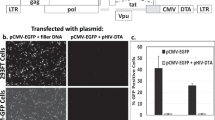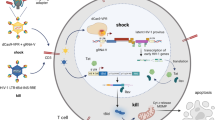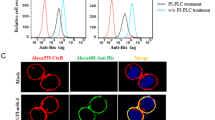Abstract
Persistence of human immunodeficiency virus (HIV) despite highly active antiretroviral therapy (HAART) is a lasting challenge to virus eradication. To develop a strategy complementary to HAART, we constructed a series of Rev-dependent lentiviral vectors carrying diphtheria toxin A chain (DT-A) and its attenuated mutants, as well as human tumor necrosis factor receptor-associated factor 6 (TRAF6). Expression of these suicide genes following delivery through viral particles is dependent on Rev, which exists only in infected cells. Among these toxins, DT-A has been known to trigger cell death with as little as a single molecule, whereas two of the attenuated mutants in this study, DT-A(176) and DT-A(ΔN), were well tolerated by cells at low levels. TRAF6 induced apoptosis only with persistent overexpression. Thus, these suicide genes, which induce cell death at different expression levels, offer a balance between efficacy and safety. To minimize possible mutagenesis introduced by retroviral integration in nontarget cells, we further developed a nonintegrating Rev-dependent (NIRD) lentiviral vector to deliver these genes. In addition, we constructed a DT-A-resistant human cell line by introducing a human elongation factor 2 mutant into HEK293T cells. This allowed us to manufacture the first high-titer NIRD lentiviral particles carrying DT-A to target HIV-positive cells.
This is a preview of subscription content, access via your institution
Access options
Subscribe to this journal
Receive 12 print issues and online access
$259.00 per year
only $21.58 per issue
Buy this article
- Purchase on Springer Link
- Instant access to full article PDF
Prices may be subject to local taxes which are calculated during checkout





Similar content being viewed by others
References
Torres RA, Barr M . Impact of combination therapy for HIV infection on inpatient census. N Engl J Med 1997; 336: 1531–1532.
Ramratnam B, Mittler JE, Zhang L, Boden D, Hurley A, Fang F et al. The decay of the latent reservoir of replication-competent HIV-1 is inversely correlated with the extent of residual viral replication during prolonged anti-retroviral therapy. Nat Med 2000; 6: 82–85.
Zhu T, Muthui D, Holte S, Nickle D, Feng F, Brodie S et al. Evidence for human immunodeficiency virus type 1 replication in vivo in CD14(+) monocytes and its potential role as a source of virus in patients on highly active antiretroviral therapy. J Virol 2002; 76: 707–716.
Sedaghat AR, Siliciano JD, Brennan TP, Wilke CO, Siliciano RF . Limits on replenishment of the resting CD4+ T cell reservoir for HIV in patients on HAART. PLoS Pathog 2007; 3: e122.
Dybul M, Daucher M, Jensen MA, Hallahan CW, Chun TW, Belson M et al. Genetic characterization of rebounding human immunodeficiency virus type 1 in plasma during multiple interruptions of highly active antiretroviral therapy. J Virol 2003; 77: 3229–3237.
Finzi D, Hermankova M, Pierson T, Carruth LM, Buck C, Chaisson RE et al. Identification of a reservoir for HIV-1 in patients on highly active antiretroviral therapy [see comments]. Science 1997; 278: 1295–1300.
Chun TW, Stuyver L, Mizell SB, Ehler LA, Mican JA, Baseler M et al. Presence of an inducible HIV-1 latent reservoir during highly active antiretroviral therapy. Proc Natl Acad Sci USA 1997; 94: 13193–13197.
Wong JK, Hezareh M, Gunthard HF, Havlir DV, Ignacio CC, Spina CA et al. Recovery of replication-competent HIV despite prolonged suppression of plasma viremia (see comments). Science 1997; 278: 1291–1295.
Furtado MR, Callaway DS, Phair JP, Kunstman KJ, Stanton JL, Macken CA et al. Persistence of HIV-1 transcription in peripheral-blood mononuclear cells in patients receiving potent antiretroviral therapy. N Engl J Med 1999; 340: 1614–1622.
Lambotte O, Taoufik Y, de Goer MG, Wallon C, Goujard C, Delfraissy JF . Detection of infectious HIV in circulating monocytes from patients on prolonged highly active antiretroviral therapy. J Acquir Immune Defic Syndr 2000; 23: 114–119.
Crowe SM, Sonza S . HIV-1 can be recovered from a variety of cells including peripheral blood monocytes of patients receiving highly active antiretroviral therapy: a further obstacle to eradication. J Leukoc Biol 2000; 68: 345–350.
Finzi D, Blankson J, Siliciano JD, Margolick JB, Chadwick K, Pierson T et al. Latent infection of CD4+ T cells provides a mechanism for lifelong persistence of HIV-1, even in patients on effective combination therapy. Nat Med 1999; 5: 512–517.
Koenig S, Gendelman HE, Orenstein JM, Dal Canto MC, Pezeshkpour GH, Yungbluth M et al. Detection of AIDS virus in macrophages in brain tissue from AIDS patients with encephalopathy. Science 1986; 233: 1089–1093.
Ramratnam B, Ribeiro R, He T, Chung C, Simon V, Vanderhoeven J et al. Intensification of antiretroviral therapy accelerates the decay of the HIV-1 latent reservoir and decreases, but does not eliminate, ongoing virus replication. J Acquir Immune Defic Syndr 2004; 35: 33–37.
Sonza S, Mutimer HP, Oelrichs R, Jardine D, Harvey K, Dunne A et al. Monocytes harbour replication-competent, non-latent HIV-1 in patients on highly active antiretroviral therapy. AIDS 2001; 15: 17–22.
Igarashi T, Brown CR, Endo Y, Buckler-White A, Plishka R, Bischofberger N et al. Macrophage are the principal reservoir and sustain high virus loads in rhesus macaques after the depletion of CD4+ T cells by a highly pathogenic simian immunodeficiency virus/HIV type 1 chimera (SHIV): implications for HIV-1 infections of humans. Proc Natl Acad Sci USA 2001; 98: 658–663.
Chomont N, El-Far M, Ancuta P, Trautmann L, Procopio FA, Yassine-Diab B et al. HIV reservoir size and persistence are driven by T cell survival and homeostatic proliferation. Nat Med 2009; 15: 893–900.
Aquaro S, Calio R, Balestra E, Bagnarelli P, Cenci A, Bertoli A et al. Clinical implications of HIV dynamics and drug resistance in macrophages. J Biol Regul Homeost Agents 1998; 12: 23–27.
Autran B, Carcelain G, Li TS, Blanc C, Mathez D, Tubiana R et al. Positive effects of combined antiretroviral therapy on CD4+ T cell homeostasis and function in advanced HIV disease. Science 1997; 277: 112–116.
Perelson AS, Essunger P, Cao Y, Vesanen M, Hurley A, Saksela K et al. Decay characteristics of HIV-1-infected compartments during combination therapy. Nature 1997; 387: 188–191.
Richman DD, Margolis DM, Delaney M, Greene WC, Hazuda D, Pomerantz RJ . The challenge of finding a cure for HIV infection. Science 2009; 323: 1304–1307.
Rosenberg ES, Billingsley JM, Caliendo AM, Boswell SL, Sax PE, Kalams SA et al. Vigorous HIV-1-specific CD4+ T cell responses associated with control of viremia. Science 1997; 278: 1447–1450.
Hatano H, Vogel S, Yoder C, Metcalf JA, Dewar R, Davey Jr RT et al. Pre-HAART HIV burden approximates post-HAART viral levels following interruption of therapy in patients with sustained viral suppression. AIDS 2000; 14: 1357–1363.
Davey Jr RT, Bhat N, Yoder C, Chun TW, Metcalf JA, Dewar R et al. HIV-1 and T cell dynamics after interruption of highly active antiretroviral therapy (HAART) in patients with a history of sustained viral suppression. Proc Natl Acad Sci USA 1999; 96: 15109–15114.
Young J, Tang Z, Yu Q, Yu D, Wu Y . Selective killing of HIV-1-positive macrophages and T Cells by the Rev-dependent lentivirus carrying anthrolysin O from Bacillus anthracis. Retrovirology 2008; 5: 36.
Shannon JG, Ross CL, Koehler TM, Rest RF . Characterization of anthrolysin O, the Bacillus anthracis cholesterol-dependent cytolysin. Infect Immun 2003; 71: 3183–3189.
King W, Patel MD, Lobel LI, Goff SP, Nguyen-Huu MC . Insertion mutagenesis of embryonal carcinoma cells by retroviruses. Science 1985; 228: 554–558.
Li Z, Dullmann J, Schiedlmeier B, Schmidt M, von Kalle C, Meyer J et al. Murine leukemia induced by retroviral gene marking. Science 2002; 296: 497.
Greenfield L, Bjorn MJ, Horn G, Fong D, Buck GA, Collier RJ et al. Nucleotide sequence of the structural gene for diphtheria toxin carried by corynebacteriophage beta. Proc Natl Acad Sci USA 1983; 80: 6853–6857.
Kochi SK, Collier RJ . DNA fragmentation and cytolysis in U937 cells treated with diphtheria toxin or other inhibitors of protein synthesis. Exp Cell Res 1993; 208: 296–302.
Yamaizumi M, Mekada E, Uchida T, Okada Y . One molecule of diphtheria toxin fragment A introduced into a cell can kill the cell. Cell 1978; 15: 245–250.
Kunitomi M, Takayama E, Suzuki S, Yasuda T, Tsutsui K, Nagaike K et al. Selective inhibition of hepatoma cells using diphtheria toxin A under the control of the promoter/enhancer region of the human alpha-fetoprotein gene. Jpn J Cancer Res 2000; 91: 343–350.
Kelley VE, Bacha P, Pankewycz O, Nichols JC, Murphy JR, Strom TB . Interleukin 2-diphtheria toxin fusion protein can abolish cell-mediated immunity in vivo. Proc Natl Acad Sci USA 1988; 85: 3980–3984.
Arora N, Masood R, Zheng T, Cai J, Smith DL, Gill PS . Vascular endothelial growth factor chimeric toxin is highly active against endothelial cells. Cancer Res 1999; 59: 183–188.
Kuzel TM, Rosen ST, Gordon LI, Winter J, Samuelson E, Kaul K et al. Phase I trial of the diphtheria toxin/interleukin-2 fusion protein DAB486IL-2: efficacy in mycosis fungoides and other non-Hodgkin's lymphomas. Leuk Lymphoma 1993; 11: 369–377.
Frankel AE, Powell BL, Hall PD, Case LD, Kreitman RJ . Phase I trial of a novel diphtheria toxin/granulocyte macrophage colony-stimulating factor fusion protein (DT388GMCSF) for refractory or relapsed acute myeloid leukemia. Clin Cancer Res 2002; 8: 1004–1013.
Frankel AE, Surendranathan A, Black JH, White A, Ganjoo K, Cripe LD . Phase II clinical studies of denileukin diftitox diphtheria toxin fusion protein in patients with previously treated chronic lymphocytic leukemia. Cancer 2006; 106: 2158–2164.
Li Y, McCadden J, Ferrer F, Kruszewski M, Carducci M, Simons J et al. Prostate-specific expression of the diphtheria toxin A chain (DT-A): studies of inducibility and specificity of expression of prostate-specific antigen promoter-driven DT-A adenoviral-mediated gene transfer. Cancer Res 2002; 62: 2576–2582.
He L, Wu X, Siegel R, Lipsky PE . TRAF6 regulates cell fate decisions by inducing caspase 8-dependent apoptosis and the activation of NF-kappa B. J Biol Chem 2006; 281: 11235–11249.
Engelman A, Englund G, Orenstein JM, Martin MA, Craigie R . Multiple effects of mutations in human immunodeficiency virus type 1 integrase on viral replication. J Virol 1995; 69: 2729–2736.
Wu Y, Marsh JW . Selective transcription and modulation of resting T cell activity by preintegrated HIV DNA. Science 2001; 293: 1503–1506.
Wu Y, Marsh JW . Early transcription from nonintegrated DNA in human immunodeficiency virus infection. J Virol 2003; 77: 10376–10382.
Kelly J, Beddall MH, Yu D, Iyer SR, Marsh JW, Wu Y . Human macrophages support persistent transcription from unintegrated HIV-1 DNA. Virology 2008; 372: 300–312.
Iyer S, Yu D, Biancotto A, Margolis L, Wu Y . Measurement of HIV-1 preintegration transcription using the Rev-dependent Rev-CEM cell reveals a sizable transcribing DNA population comparable with proviral templates. J Virol 2009.
Philippe S, Sarkis C, Barkats M, Mammeri H, Ladroue C, Petit C et al. Lentiviral vectors with a defective integrase allow efficient and sustained transgene expression in vitro and in vivo. Proc Natl Acad Sci USA 2006; 103: 17684–17689.
Vargas Jr J, Klotman ME, Cara A . Conditionally replicating lentiviral-hybrid episomal vectors for suicide gene therapy. Antiviral Res 2008; 80: 288–294.
Vargas Jr J, Gusella GL, Najfeld V, Klotman ME, Cara A . Novel integrase-defective lentiviral episomal vectors for gene transfer. Hum Gene Ther 2004; 15: 361–372.
Wu Y, Beddall MH, Marsh JW . Rev-dependent indicator T cell line. Curr HIV Res 2007; 5: 395–403.
Wu Y, Beddall MH, Marsh JW . Rev-dependent lentiviral expression vector. Retrovirology 2007; 4: 12.
Naldini L, Blomer U, Gallay P, Ory D, Mulligan R, Gage FH et al. In vivo gene delivery and stable transduction of nondividing cells by a lentiviral vector. Science 1996; 272: 263–267.
Fisher KS, Maxwell IH, Murphy JR, Collier J, Glode LM . Construction and expression of plasmids containing mutated diphtheria toxin A-chain-coding sequences. Infect Immun 1991; 59: 3562–3565.
Maxwell F, Maxwell IH, Glode LM . Cloning, sequence determination, and expression in transfected cells of the coding sequence for the tox 176 attenuated diphtheria toxin A chain. Mol Cell Biol 1987; 7: 1576–1579.
Kohno K, Uchida T . Highly frequent single amino acid substitution in mammalian elongation factor 2 (EF-2) results in expression of resistance to EF-2-ADP-ribosylating toxins. J Biol Chem 1987; 262: 12298–12305.
Gelderblom HC, Vatakis DN, Burke SA, Lawrie SD, Bristol GC, Levy DN . Viral complementation allows HIV-1 replication without integration. Retrovirology 2008.
Perez VL, Rowe T, Justement JS, Butera ST, June CH, Folks TM . An HIV-1-infected T cell clone defective in IL-2 production and Ca2+ mobilization after CD3 stimulation. J Immunol 1991; 147: 3145–3148.
He J, Choe S, Walker R, Di Marzio P, Morgan DO, Landau NR . Human immunodeficiency virus type 1 viral protein R (Vpr) arrests cells in the G2 phase of the cell cycle by inhibiting p34cdc2 activity. J Virol 1995; 69: 6705–6711.
Marsden MD, Zack JA . Eradication of HIV: current challenges and new directions. J Antimicrob Chemother 2009; 63: 7–10.
Chun TW, Davey Jr RT, Engel D, Lane HC, Fauci AS . Re-emergence of HIV after stopping therapy (in process citation). Nature 1999; 401: 874–875.
Gaur M, Leavitt AD . Mutations in the human immunodeficiency virus type 1 integrase D,D(35)E motif do not eliminate provirus formation. J Virol 1998; 72: 4678–4685.
Leavitt AD, Robles G, Alesandro N, Varmus HE . Human immunodeficiency virus type 1 integrase mutants retain in vitro integrase activity yet fail to integrate viral DNA efficiently during infection. J Virol 1996; 70: 721–728.
Aquaro S, Calio R, Balzarini J, Bellocchi MC, Garaci E, Perno CF . Macrophages and HIV infection: therapeutical approaches toward this strategic virus reservoir. Antiviral Res 2002; 55: 209–225.
Stellbrink HJ, Hufert FT, Tenner-Racz K, Lauer J, Schneider C, Albrecht H et al. Kinetics of productive and latent HIV infection in lymphatic tissue and peripheral blood during triple-drug combination therapy with or without additional interleukin-2. Antivir Ther 1998; 3: 209–214.
Chun TW, Engel D, Mizell SB, Hallahan CW, Fischette M, Park S et al. Effect of interleukin-2 on the pool of latently infected, resting CD4+ T cells in HIV-1-infected patients receiving highly active anti-retroviral therapy (see comments). Nat Med 1999; 5: 651–655.
Karin M, Lin A . NF-kappaB at the crossroads of life and death. Nat Immunol 2002; 3: 221–227.
Greene C, O’Neill L . Interleukin-1 receptor-associated kinase and TRAF-6 mediate the transcriptional regulation of interleukin-2 by interleukin-1 via NFkappaB but unlike interleukin-1 are unable to stabilise interleukin-2 mRNA. Biochim Biophys Acta 1999; 1451: 109–121.
Matsumura T, Degawa T, Takii T, Hayashi H, Okamoto T, Inoue J et al. TRAF6-NF-kappaB pathway is essential for interleukin-1-induced TLR2 expression and its functional response to TLR2 ligand in murine hepatocytes. Immunology 2003; 109: 127–136.
Goor RS, Pappenheimer Jr AM . Studies on the mode of action of diphtheria toxin. 3. Site of toxin action in cell-free extracts. J Exp Med 1967; 126: 899–912.
Collier RJ . Effect of diphtheria toxin on protein synthesis: inactivation of one of the transfer factors. J Mol Biol 1967; 25: 83–98.
Collier RJ . Diphtheria toxin: mode of action and structure. Bacteriol Rev 1975; 39: 54–85.
Collier RJ . Understanding the mode of action of diphtheria toxin: a perspective on progress during the 20th century. Toxicon 2001; 39: 1793–1803.
Potala S, Sahoo SK, Verma RS . Targeted therapy of cancer using diphtheria toxin-derived immunotoxins. Drug Discov Today 2008; 13: 807–815.
Woo JH, Liu YY, Mathias A, Stavrou S, Wang Z, Thompson J et al. Gene optimization is necessary to express a bivalent anti-human anti-T cell immunotoxin in Pichia pastoris. Protein Expr Purif 2002; 25: 270–282.
Foley GE, Lazarus H, Farber S, Uzman BG, Boone BA, McCarthy RE . Continuous culture of human lymphoblasts from peripheral blood of a child with acute leukemia. Cancer 1965; 18: 522–529.
Neville Jr DM, Scharff J, Hu HZ, Rigaut K, Shiloach J, Slingerland W et al. A new reagent for the induction of T-cell depletion, anti-CD3-CRM9. J Immunother Emphasis Tumor Immunol 1996; 19: 85–92.
Acknowledgements
We thank the George Mason University Student Health Center for blood donations; the NIH AIDS Research & Reference Reagent Program, NIAID, NIH, for reagents; David M Neville for his help on DT-A cloning and discussions; Jeffrey Guo and Wei Ao for technical assistance; and Jennifer Guernsey for editorial assistance. This work was supported by Public Health Service Grant NS051130 (to YW) from NINDS and AI069981, AI081568 (to YW) from NIAID. Yanfang Zheng was supported by the generous donations of the donors and riders of the 2008 NYCDC AIDS ride organized by Marty Rosen and Day2 Inc.
Author information
Authors and Affiliations
Corresponding author
Ethics declarations
Competing interests
The authors declare no conflict of interest.
Additional information
Supplementary Information accompanies the paper on Gene Therapy website
Supplementary information
Rights and permissions
About this article
Cite this article
Wang, Z., Tang, Z., Zheng, Y. et al. Development of a nonintegrating Rev-dependent lentiviral vector carrying diphtheria toxin A chain and human TRAF6 to target HIV reservoirs. Gene Ther 17, 1063–1076 (2010). https://doi.org/10.1038/gt.2010.53
Received:
Revised:
Accepted:
Published:
Issue Date:
DOI: https://doi.org/10.1038/gt.2010.53
Keywords
This article is cited by
-
A traditional medicine, respiratory detox shot (RDS), inhibits the infection of SARS-CoV, SARS-CoV-2, and the influenza A virus in vitro
Cell & Bioscience (2021)
-
Diphtheria Toxin A-Resistant Cell Lines Enable Robust Production and Evaluation of DTA-Encoding Lentiviruses
Scientific Reports (2019)
-
BRCA1 functions as a novel transcriptional cofactor in HIV-1 infection
Virology Journal (2015)
-
A Lentiviral Vector Expressing Desired Gene Only in Transduced Cells: An Approach for Suicide Gene Therapy
Molecular Biotechnology (2015)



